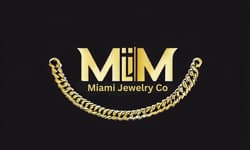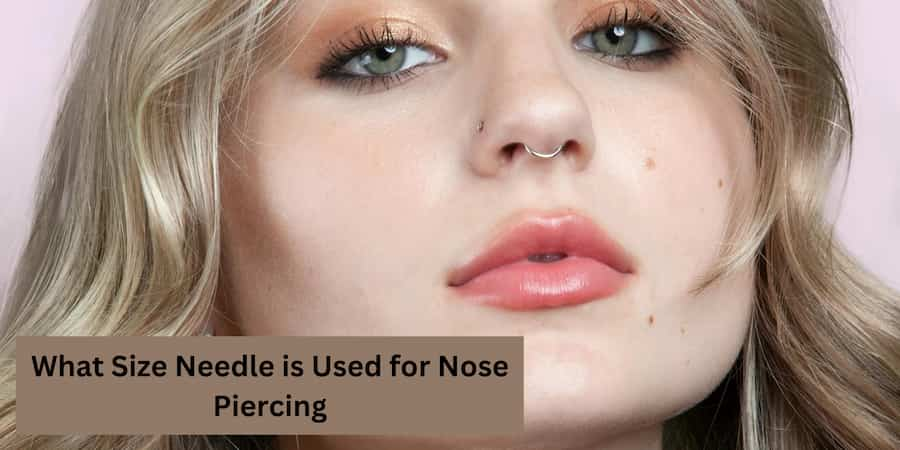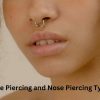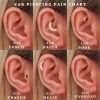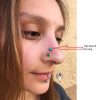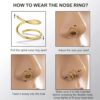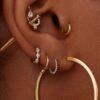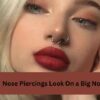Nose Piercing
What Size Needle is Used for Nose Piercing? How to Choose the Best One
Ever stood in front of a mirror, daydreaming about that perfect nose piercing but halted by the nagging question –
“What size needle should be used?”
You’re not alone. The fear of an oversized needle causing more pain or a tiny one leading to complications can be, quite literally, a pointy dilemma. And, while most believe that nose piercing is just about choosing a trendy stud, the unsung hero behind a successful piercing is, in fact, the right needle size.
Dive into this guide to uncover not just the size, but also the science behind the perfect nose piercing. We’ll navigate the world of piercing needles, unravel the importance of dimensions, and provide you with a blueprint on how to select the best one for a painless and smooth piercing experience.
So, if you’re on the fence about that dreamy nose stud, by the end of this article, you’ll know exactly how to jump off, needle-first.
Contents
- 1 Importance of Picking the Right Needle Size:
- 2 The Basics of Nose Piercing Needles:
- 3 How Big is a Nose Piercing Needle?
- 4 Why Needle Size Matters:
- 5 Choosing the Best Needle Size for Your Nose:
- 6 Professional Input on Piercing:
- 7 Comprehensive Guide to Piercing Needle Sizes with Gauge Chart
- 8 Types of Piercing Needles:
- 9 How to Sterilize Piercing Needles/Sewing Needles?
- 10 How to Use Piercing Needles?
- 11 Caring for Your New Piercing:
- 12 Common Mistakes to Avoid:
- 13 FAQs
- 14 Conclusion:
Importance of Picking the Right Needle Size:
If you want a nose piercing, you need to think about more than just the jewelry. The needle used for the piercing is super important. Choosing the right needle makes the piercing safer and helps it heal faster.
The Basics of Nose Piercing Needles:
What are Piercing Needles and Why are They Used?
Piercing needles are special tools. They are made to pierce the skin safely and cleanly. They are not like the needles you might see someone use at home (which isn’t a good idea!). These special needles make sure the piercing is done right and heals well.
How are Piercing Needles Different from Other Needles?
Normal sewing needles or the kind doctors use are not for piercings. These needles can hurt the skin more. But piercing needles are made to move skin cells aside without taking any out. This is safer and helps the piercing heal better.
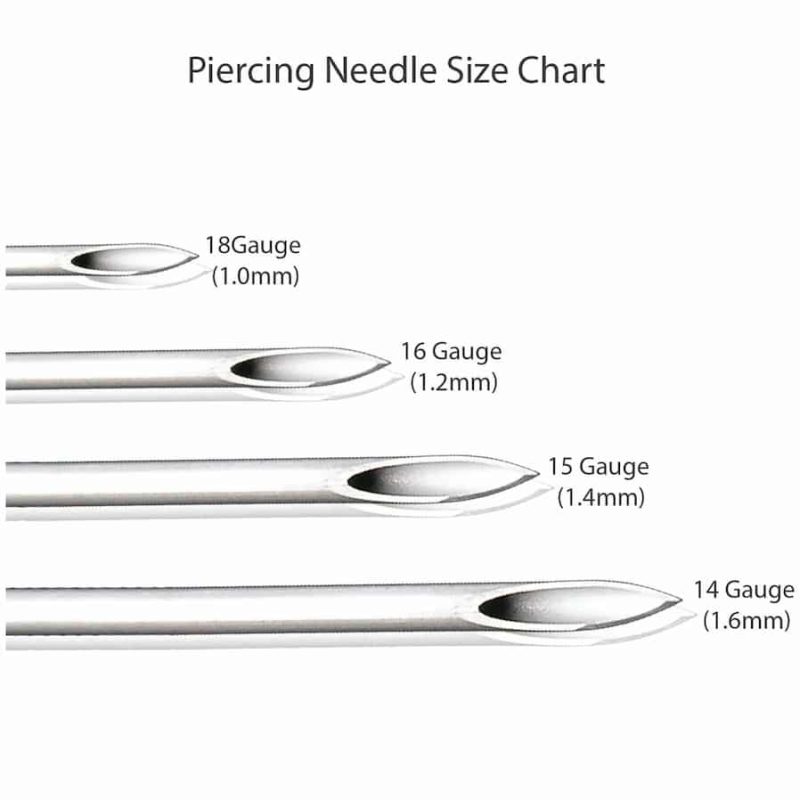
How Big is a Nose Piercing Needle?
Common Sizes Used by Experts:
When people get nose piercings, there are usual sizes that experts use. Most of the time, they use needles that are 18 to 20 gauge. These sizes fit well with nose jewelry.
What Helps Decide the Right Size?
Choosing the needle isn’t just random. It depends on the person’s nose, the kind of jewelry they want, and where on the nose the piercing will be. A professional will look at all these things before choosing the best needle.
What Does “Gauge” Mean?
“Gauge” is a word that talks about how thick the needle is. It might sound a bit funny, but a bigger gauge number means a thinner needle. So, even though 20 sounds bigger than 18, the 20-gauge needle is actually thinner!
Common Gauge Sizes for Nose Piercings:
Like we said before, 18 and 20 gauge needles are used a lot for nose piercings. Sometimes, if someone wants a certain type of jewelry or a different kind of piercing, the piercer might use a 16-gauge needle. It’s always good to talk to an expert to know what’s best.
Why Needle Size Matters:
The Relationship Between Needle Size and Healing Time:
Ever wondered why there are different sizes of needles for piercings? Well, the size directly impacts how quickly your piercing heals. A needle that’s just right for your nose ensures a clean, neat hole, helping your skin recover faster.
Ensuring Minimal Pain and Complications:
Let’s face it, we all want less pain. Choosing the right needle size makes the piercing process smoother. Plus, it reduces the risk of problems later on, like infections or uneven healing.
Choosing the Best Needle Size for Your Nose:
Factors to Consider:
When picking a needle size, you should think about the type of jewelry you want and the unique shape of your nose. Everyone’s nose is different, and what works for one person might not work for another.
Recommendations for First-Time Piercees:
If you’re new to this, I’d suggest sticking to the standard sizes – 18 or 20 gauge. These sizes usually work best for most nose jewelry, and they offer a good balance between comfort and healing.
Professional Input on Piercing:
Why It’s Beneficial to Consult with a Professional Piercer:
A pro has seen and done it all! They’ll give you advice based on their experience. Plus, they can help you figure out the best needle size and jewelry for your nose.
The Dangers of DIY Nose Piercing:
I get it, DIY can be tempting. But when it comes to your body, you shouldn’t take chances. Piercing your nose at home can lead to crooked piercings, infections, and a lot more pain than necessary.
Comprehensive Guide to Piercing Needle Sizes with Gauge Chart
When considering a piercing, it’s paramount to understand the variety of needle sizes and the piercings they best suit. Below is a detailed table that breaks down the gauge sizes, standard sizes, and the associated piercing types:
| Gauge (G) | Standard Size | Recommended Piercing |
|---|---|---|
| 18G and 20G | – | Ears and Nose |
| 14G | 3/8” and 7/16” | Belly/Navel Ring |
| 14G | 3/8” and 1/2” | Nipple |
| 14G | 5/8” | Tongue |
| 14G | 3/8”, 7/16”, 1/2”, 5/8” | Septum |
| 16G, 18G | 1/4”, 5/16”, 3/8” | Tragus, Helix, Rook, Conch |
| 16G | 1/4”, 5/16”, 3/8” | Monroe |
| 14G or 16G | 1/4”, 5/16”, 3/8” | Labret and Eyebrow |
With this table as your guide, you’re better equipped to make informed decisions about your piercing journey, ensuring not only an aesthetic result but also optimal healing and comfort.
Related
Types of Piercing Needles:
You might be thinking, “A needle’s a needle, right?” Not quite. Here’s a quick rundown:
- Standard Needles: These are the most common, and they push skin cells out of the way rather than removing them.
- Cannula Needles: These come with a plastic sheath around them, useful for more complex piercings because they leave the sheath in place once the needle is removed, making jewelry insertion smoother.
- Dermal Punches: Not really a “needle”, but I thought you should know. They remove a small circle of flesh for particular types of piercings, like dermal.
Choosing the right needle type is crucial, not only for comfort but also for the healing process.
How to Sterilize Piercing Needles/Sewing Needles?
Sterilization is crucial. The last thing you want is an infection. Here’s how you can sterilize needles:
- Autoclave: This is the gold standard for professionals. It uses pressure and steam to kill all microorganisms.
- Boiling: For those at home, boiling a needle in water for 20 minutes can sterilize it. But remember, sterilizing a sewing needle doesn’t make it suitable for piercing!
- Alcohol: Soaking in 70% isopropyl alcohol for about 30 minutes can disinfect, but it might not kill all pathogens.
However, a friendly reminder: If you’re considering a piercing, always go to a professional. They have the tools, knowledge, and environment to ensure safety.
How to Use Piercing Needles?
The art of piercing isn’t just about pushing a needle through the skin. It requires precision and knowledge. Here’s a basic step-by-step:
- Preparation: Clean the area to be pierced with an antiseptic solution.
- Marking: Using a skin-safe marker, pinpoint exactly where you want the piercing.
- Positioning: Stretch the skin taut using fingers or clamps. It helps the needle pass through smoothly.
- Piercing: Insert the needle at a steady, even pace. Make sure it goes in straight and comes out at the desired exit point.
- Jewelry Insertion: Once the needle is through, follow it up with the jewelry, sliding it into place.
- Aftercare: Clean the area and make sure to follow all aftercare guidelines to ensure smooth healing.
Remember, while these steps might make it sound simple, it’s always recommended to let professionals handle piercings.
Caring for Your New Piercing:
Immediate Aftercare Practices:
After getting pierced, cleanliness is key. Clean your piercing with saline solution twice a day. Avoid touching it too much, and keep makeup and other products away from the area.
Long-Term Care to Ensure Proper Healing and Maintenance:
Even after the piercing feels healed, continue to be gentle with it. Avoid tugging on the jewelry or changing it too often. This helps make sure your piercing stays healthy in the long run.
Common Mistakes to Avoid:
Overlooking Needle and Jewelry Sizes:
It’s easy to get excited about the jewelry and forget about the needle. But both are important. Make sure you choose sizes that are right for your nose and for each other.
Not Seeking Professional Guidance:
Trying to figure everything out on your own can be tough. It’s always better to get advice from someone who knows what they’re doing. This will save you pain and trouble later on.
FAQs
What size is a nose piercing needle?
Typically, a nose piercing needle will range between 18 to 20 gauge in size. This aligns well with most standard nose jewelry options.
Can I use a 14 gauge needle for nose piercing?
While a 14-gauge needle can technically be used for a nose piercing, it’s larger than the typical 18 to 20-gauge needles commonly used. Using a 14 gauge might be suitable for specific jewelry types or piercings, but always consult with a professional before deciding.
Is a 16 gauge needle big for a piercing?
A 16 gauge needle is considered a middle-ground size in piercing. It’s larger than what’s typically used for standard nostril piercings (18-20 gauge), but might be suitable for other nose piercings like the septum.
What MM is best for nose piercing?
In terms of millimeters (mm), a typical nose piercing is about 1mm (18 gauge) to 0.8mm (20 gauge) in diameter. These sizes fit well with most nose jewelry and ensure a smooth healing process.
What is the standard gauge size for nose piercings?
The standard gauge size for most nose piercings is either 18 or 20 gauge. However, the exact size can depend on the individual’s anatomy and the specific jewelry chosen.
How long does a nose piercing take to heal based on needle size?
The healing time for a nose piercing can range from 2 to 4 months. While the needle size plays a role, the aftercare, the individual’s health, and the piercing location also influence healing time. Generally, appropriately sized needles promote faster and complication-free healing.
Can I change the jewelry right after getting pierced?
No, it’s recommended to wait until the piercing has fully healed before changing the jewelry. Changing it too soon can cause complications, infections, and prolong the healing process.
Is there a significant difference in pain between different needle sizes?
While there might be slight variations in pain perception based on needle size, the technique of the piercer and the individual’s pain threshold play more significant roles. Generally, a correctly performed piercing with any standard needle size should be bearable for most people.
How often should I clean my nose piercing initially?
It’s essential to clean a new nose piercing twice a day using a saline solution. Regular cleaning helps prevent infections and promotes faster healing.
Conclusion:
Remember, when getting a nose piercing, the right needle size can make a big difference. It affects how your piercing looks, how it heals, and how it feels. So, always think about safety and make sure to ask the pros for their advice. They’re here to help you have the best piercing experience possible. Why take risks when you can be sure?
Further Reading for Piercing Enthusiasts:
- How To Reopen A Closed Nose Piercing
- Septum Piercing
- Double Nose Piercing
- Nasallang Piercing
- Rhino Piercing
- High Nostril Piercing
- Mantis Piercing
- Is Titanium Good For Nose Piercings
- Foods To Avoid After Nose Piercing
- What Gauge Is A Nose Piercing

Camila Luna is a passionate jewelry enthusiast and content creator at Miami Jewelry Co. With a focus on providing high-quality, Miami-style jewelry, Camila and her team specialize in a wide range of jewelry that includes bracelets, necklaces, earrings, and more
